Evidence-Based Article Appraisal: Studies on Urinary Catheter Use
VerifiedAdded on 2023/06/08
|12
|2263
|397
Report
AI Summary
This assignment presents an evidence-based appraisal of several research articles focusing on the use of urinary catheters and related healthcare outcomes. The appraisal examines studies addressing the reduction of unnecessary catheter use through cost analysis systems, the impact of educational interventions on Foley catheter insertion and maintenance, the efficacy of silver-impregnated catheters in preventing bacteriuria and funguria, the correlation between UTI diagnoses and catheter use, and the association between Foley catheter use for cervical ripening and infectious morbidity. Each article is assessed for research design, sample size, results, limitations, and overall quality, providing a comprehensive evaluation of the evidence supporting various strategies for improving patient care and reducing catheter-associated urinary tract infections (CAUTI).
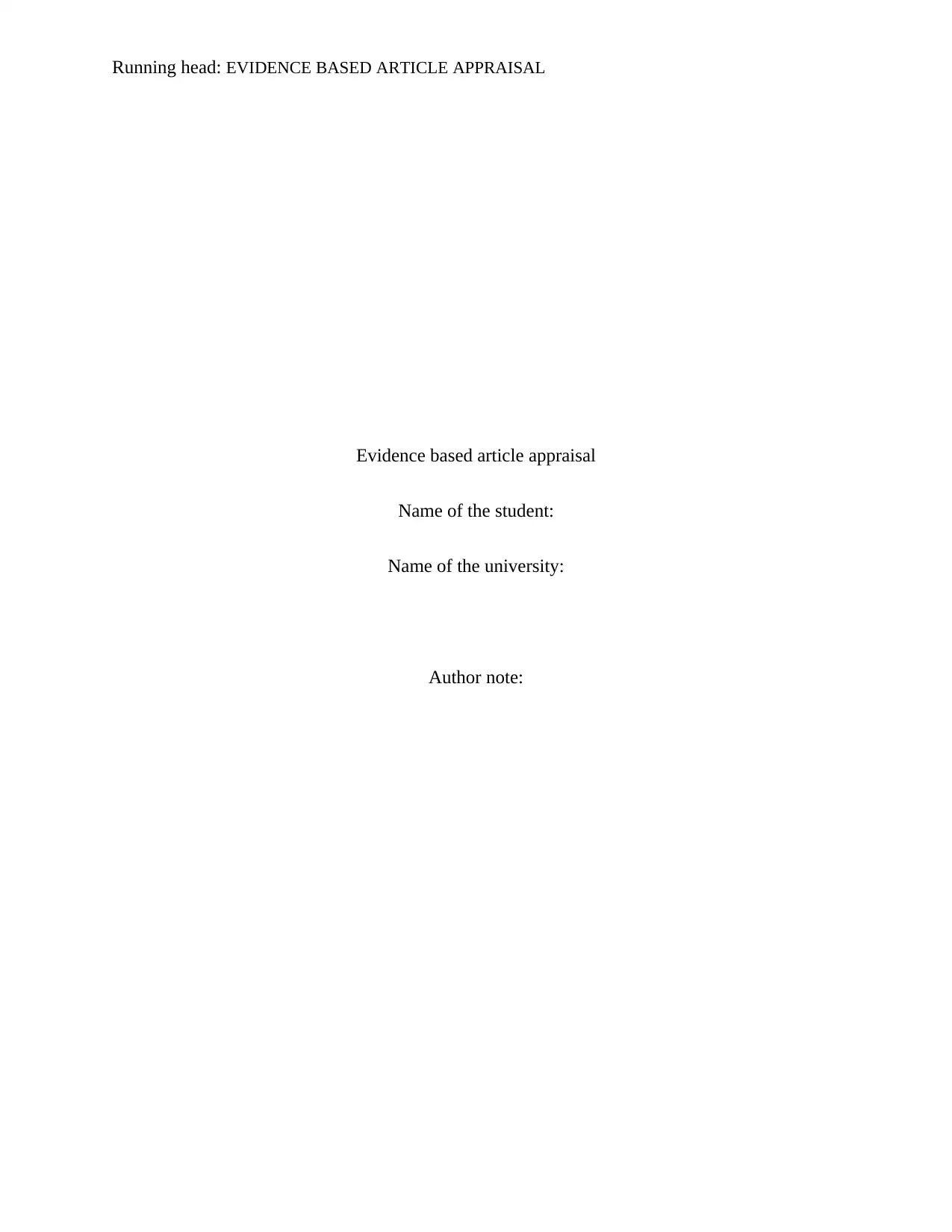
Running head: EVIDENCE BASED ARTICLE APPRAISAL
Evidence based article appraisal
Name of the student:
Name of the university:
Author note:
Evidence based article appraisal
Name of the student:
Name of the university:
Author note:
Paraphrase This Document
Need a fresh take? Get an instant paraphrase of this document with our AI Paraphraser
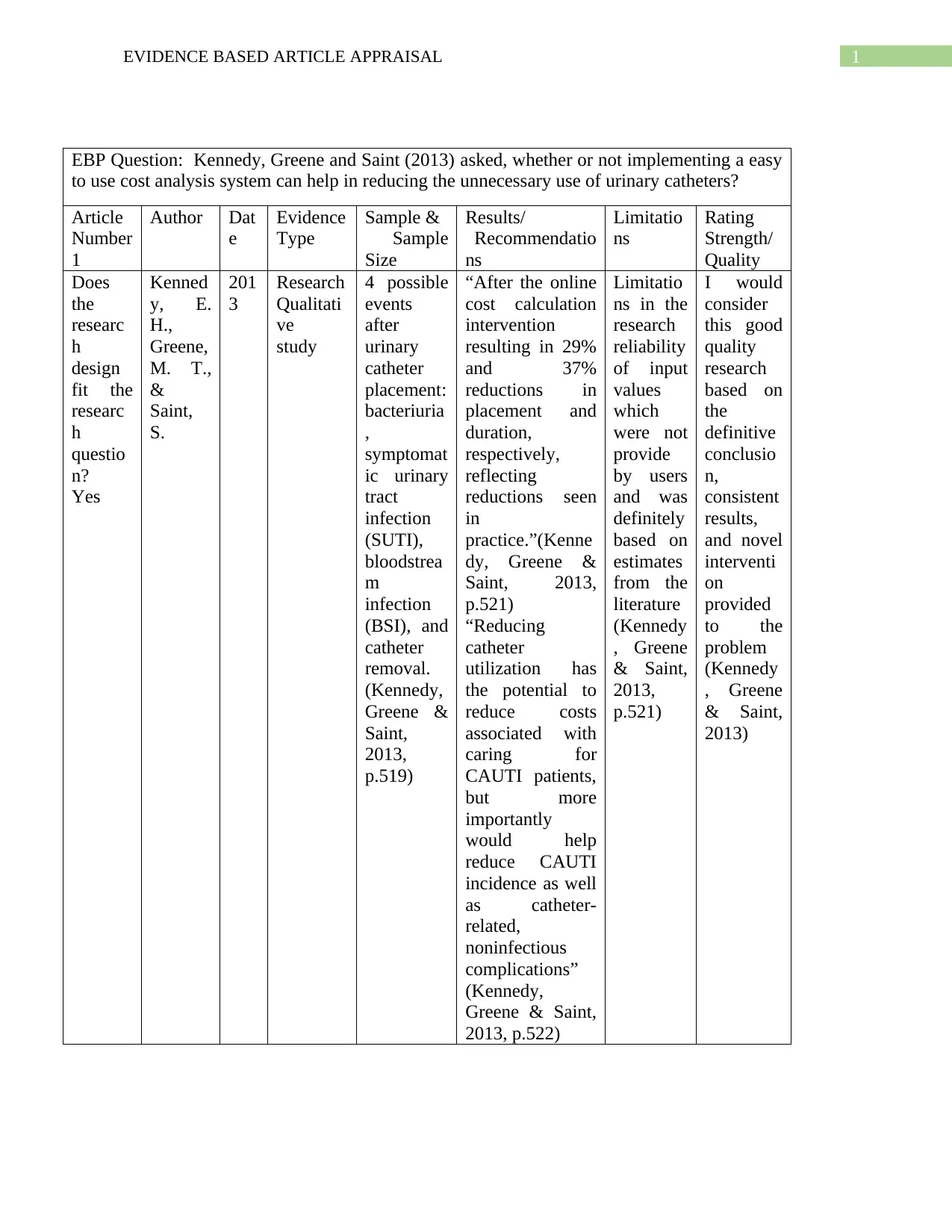
1EVIDENCE BASED ARTICLE APPRAISAL
EBP Question: Kennedy, Greene and Saint (2013) asked, whether or not implementing a easy
to use cost analysis system can help in reducing the unnecessary use of urinary catheters?
Article
Number
1
Author Dat
e
Evidence
Type
Sample &
Sample
Size
Results/
Recommendatio
ns
Limitatio
ns
Rating
Strength/
Quality
Does
the
researc
h
design
fit the
researc
h
questio
n?
Yes
Kenned
y, E.
H.,
Greene,
M. T.,
&
Saint,
S.
201
3
Research
Qualitati
ve
study
4 possible
events
after
urinary
catheter
placement:
bacteriuria
,
symptomat
ic urinary
tract
infection
(SUTI),
bloodstrea
m
infection
(BSI), and
catheter
removal.
(Kennedy,
Greene &
Saint,
2013,
p.519)
“After the online
cost calculation
intervention
resulting in 29%
and 37%
reductions in
placement and
duration,
respectively,
reflecting
reductions seen
in
practice.”(Kenne
dy, Greene &
Saint, 2013,
p.521)
“Reducing
catheter
utilization has
the potential to
reduce costs
associated with
caring for
CAUTI patients,
but more
importantly
would help
reduce CAUTI
incidence as well
as catheter-
related,
noninfectious
complications”
(Kennedy,
Greene & Saint,
2013, p.522)
Limitatio
ns in the
research
reliability
of input
values
which
were not
provide
by users
and was
definitely
based on
estimates
from the
literature
(Kennedy
, Greene
& Saint,
2013,
p.521)
I would
consider
this good
quality
research
based on
the
definitive
conclusio
n,
consistent
results,
and novel
interventi
on
provided
to the
problem
(Kennedy
, Greene
& Saint,
2013)
EBP Question: Kennedy, Greene and Saint (2013) asked, whether or not implementing a easy
to use cost analysis system can help in reducing the unnecessary use of urinary catheters?
Article
Number
1
Author Dat
e
Evidence
Type
Sample &
Sample
Size
Results/
Recommendatio
ns
Limitatio
ns
Rating
Strength/
Quality
Does
the
researc
h
design
fit the
researc
h
questio
n?
Yes
Kenned
y, E.
H.,
Greene,
M. T.,
&
Saint,
S.
201
3
Research
Qualitati
ve
study
4 possible
events
after
urinary
catheter
placement:
bacteriuria
,
symptomat
ic urinary
tract
infection
(SUTI),
bloodstrea
m
infection
(BSI), and
catheter
removal.
(Kennedy,
Greene &
Saint,
2013,
p.519)
“After the online
cost calculation
intervention
resulting in 29%
and 37%
reductions in
placement and
duration,
respectively,
reflecting
reductions seen
in
practice.”(Kenne
dy, Greene &
Saint, 2013,
p.521)
“Reducing
catheter
utilization has
the potential to
reduce costs
associated with
caring for
CAUTI patients,
but more
importantly
would help
reduce CAUTI
incidence as well
as catheter-
related,
noninfectious
complications”
(Kennedy,
Greene & Saint,
2013, p.522)
Limitatio
ns in the
research
reliability
of input
values
which
were not
provide
by users
and was
definitely
based on
estimates
from the
literature
(Kennedy
, Greene
& Saint,
2013,
p.521)
I would
consider
this good
quality
research
based on
the
definitive
conclusio
n,
consistent
results,
and novel
interventi
on
provided
to the
problem
(Kennedy
, Greene
& Saint,
2013)

2EVIDENCE BASED ARTICLE APPRAISAL
⊘ This is a preview!⊘
Do you want full access?
Subscribe today to unlock all pages.

Trusted by 1+ million students worldwide
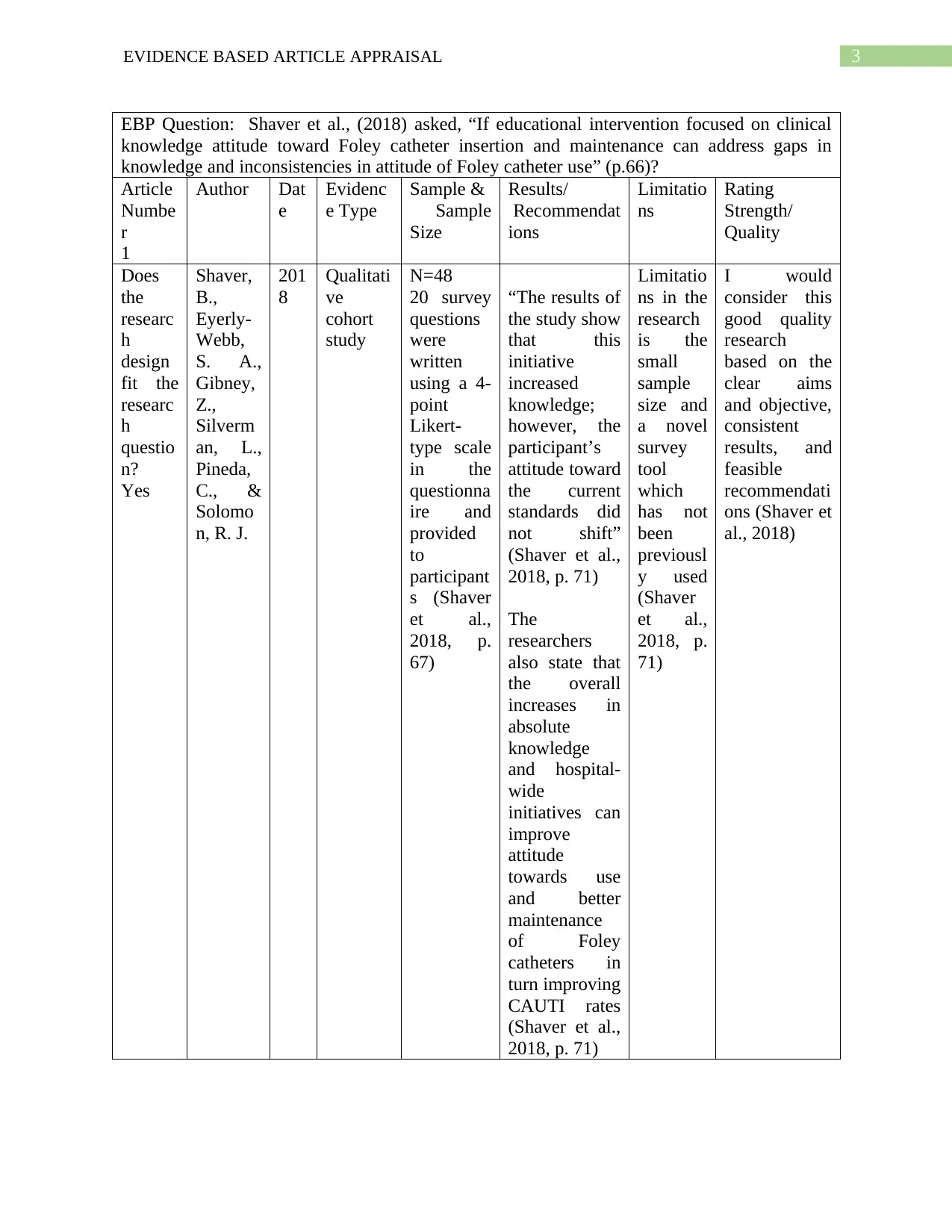
3EVIDENCE BASED ARTICLE APPRAISAL
EBP Question: Shaver et al., (2018) asked, “If educational intervention focused on clinical
knowledge attitude toward Foley catheter insertion and maintenance can address gaps in
knowledge and inconsistencies in attitude of Foley catheter use” (p.66)?
Article
Numbe
r
1
Author Dat
e
Evidenc
e Type
Sample &
Sample
Size
Results/
Recommendat
ions
Limitatio
ns
Rating
Strength/
Quality
Does
the
researc
h
design
fit the
researc
h
questio
n?
Yes
Shaver,
B.,
Eyerly-
Webb,
S. A.,
Gibney,
Z.,
Silverm
an, L.,
Pineda,
C., &
Solomo
n, R. J.
201
8
Qualitati
ve
cohort
study
N=48
20 survey
questions
were
written
using a 4-
point
Likert-
type scale
in the
questionna
ire and
provided
to
participant
s (Shaver
et al.,
2018, p.
67)
“The results of
the study show
that this
initiative
increased
knowledge;
however, the
participant’s
attitude toward
the current
standards did
not shift”
(Shaver et al.,
2018, p. 71)
The
researchers
also state that
the overall
increases in
absolute
knowledge
and hospital-
wide
initiatives can
improve
attitude
towards use
and better
maintenance
of Foley
catheters in
turn improving
CAUTI rates
(Shaver et al.,
2018, p. 71)
Limitatio
ns in the
research
is the
small
sample
size and
a novel
survey
tool
which
has not
been
previousl
y used
(Shaver
et al.,
2018, p.
71)
I would
consider this
good quality
research
based on the
clear aims
and objective,
consistent
results, and
feasible
recommendati
ons (Shaver et
al., 2018)
EBP Question: Shaver et al., (2018) asked, “If educational intervention focused on clinical
knowledge attitude toward Foley catheter insertion and maintenance can address gaps in
knowledge and inconsistencies in attitude of Foley catheter use” (p.66)?
Article
Numbe
r
1
Author Dat
e
Evidenc
e Type
Sample &
Sample
Size
Results/
Recommendat
ions
Limitatio
ns
Rating
Strength/
Quality
Does
the
researc
h
design
fit the
researc
h
questio
n?
Yes
Shaver,
B.,
Eyerly-
Webb,
S. A.,
Gibney,
Z.,
Silverm
an, L.,
Pineda,
C., &
Solomo
n, R. J.
201
8
Qualitati
ve
cohort
study
N=48
20 survey
questions
were
written
using a 4-
point
Likert-
type scale
in the
questionna
ire and
provided
to
participant
s (Shaver
et al.,
2018, p.
67)
“The results of
the study show
that this
initiative
increased
knowledge;
however, the
participant’s
attitude toward
the current
standards did
not shift”
(Shaver et al.,
2018, p. 71)
The
researchers
also state that
the overall
increases in
absolute
knowledge
and hospital-
wide
initiatives can
improve
attitude
towards use
and better
maintenance
of Foley
catheters in
turn improving
CAUTI rates
(Shaver et al.,
2018, p. 71)
Limitatio
ns in the
research
is the
small
sample
size and
a novel
survey
tool
which
has not
been
previousl
y used
(Shaver
et al.,
2018, p.
71)
I would
consider this
good quality
research
based on the
clear aims
and objective,
consistent
results, and
feasible
recommendati
ons (Shaver et
al., 2018)
Paraphrase This Document
Need a fresh take? Get an instant paraphrase of this document with our AI Paraphraser

4EVIDENCE BASED ARTICLE APPRAISAL
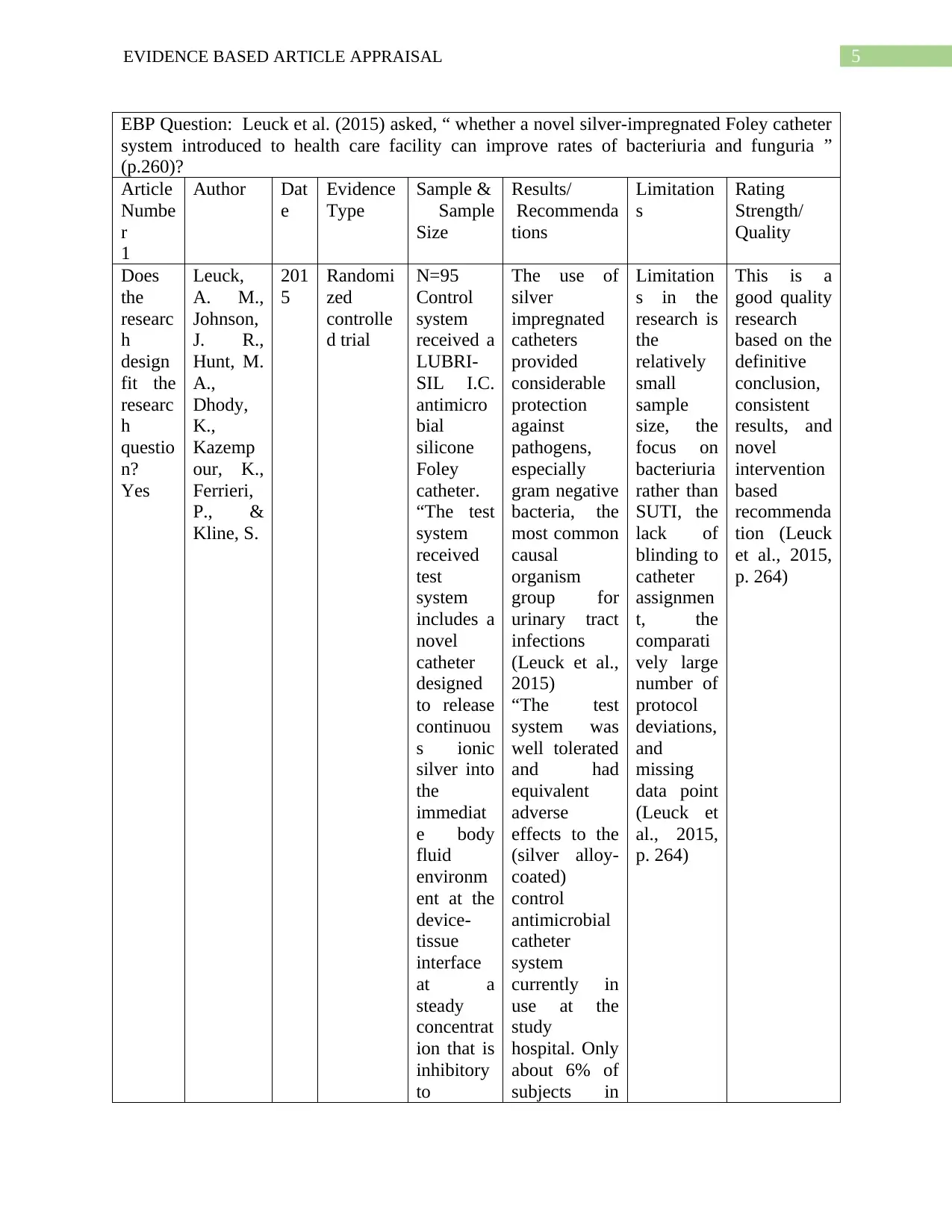
5EVIDENCE BASED ARTICLE APPRAISAL
EBP Question: Leuck et al. (2015) asked, “ whether a novel silver-impregnated Foley catheter
system introduced to health care facility can improve rates of bacteriuria and funguria ”
(p.260)?
Article
Numbe
r
1
Author Dat
e
Evidence
Type
Sample &
Sample
Size
Results/
Recommenda
tions
Limitation
s
Rating
Strength/
Quality
Does
the
researc
h
design
fit the
researc
h
questio
n?
Yes
Leuck,
A. M.,
Johnson,
J. R.,
Hunt, M.
A.,
Dhody,
K.,
Kazemp
our, K.,
Ferrieri,
P., &
Kline, S.
201
5
Randomi
zed
controlle
d trial
N=95
Control
system
received a
LUBRI-
SIL I.C.
antimicro
bial
silicone
Foley
catheter.
“The test
system
received
test
system
includes a
novel
catheter
designed
to release
continuou
s ionic
silver into
the
immediat
e body
fluid
environm
ent at the
device-
tissue
interface
at a
steady
concentrat
ion that is
inhibitory
to
The use of
silver
impregnated
catheters
provided
considerable
protection
against
pathogens,
especially
gram negative
bacteria, the
most common
causal
organism
group for
urinary tract
infections
(Leuck et al.,
2015)
“The test
system was
well tolerated
and had
equivalent
adverse
effects to the
(silver alloy-
coated)
control
antimicrobial
catheter
system
currently in
use at the
study
hospital. Only
about 6% of
subjects in
Limitation
s in the
research is
the
relatively
small
sample
size, the
focus on
bacteriuria
rather than
SUTI, the
lack of
blinding to
catheter
assignmen
t, the
comparati
vely large
number of
protocol
deviations,
and
missing
data point
(Leuck et
al., 2015,
p. 264)
This is a
good quality
research
based on the
definitive
conclusion,
consistent
results, and
novel
intervention
based
recommenda
tion (Leuck
et al., 2015,
p. 264)
EBP Question: Leuck et al. (2015) asked, “ whether a novel silver-impregnated Foley catheter
system introduced to health care facility can improve rates of bacteriuria and funguria ”
(p.260)?
Article
Numbe
r
1
Author Dat
e
Evidence
Type
Sample &
Sample
Size
Results/
Recommenda
tions
Limitation
s
Rating
Strength/
Quality
Does
the
researc
h
design
fit the
researc
h
questio
n?
Yes
Leuck,
A. M.,
Johnson,
J. R.,
Hunt, M.
A.,
Dhody,
K.,
Kazemp
our, K.,
Ferrieri,
P., &
Kline, S.
201
5
Randomi
zed
controlle
d trial
N=95
Control
system
received a
LUBRI-
SIL I.C.
antimicro
bial
silicone
Foley
catheter.
“The test
system
received
test
system
includes a
novel
catheter
designed
to release
continuou
s ionic
silver into
the
immediat
e body
fluid
environm
ent at the
device-
tissue
interface
at a
steady
concentrat
ion that is
inhibitory
to
The use of
silver
impregnated
catheters
provided
considerable
protection
against
pathogens,
especially
gram negative
bacteria, the
most common
causal
organism
group for
urinary tract
infections
(Leuck et al.,
2015)
“The test
system was
well tolerated
and had
equivalent
adverse
effects to the
(silver alloy-
coated)
control
antimicrobial
catheter
system
currently in
use at the
study
hospital. Only
about 6% of
subjects in
Limitation
s in the
research is
the
relatively
small
sample
size, the
focus on
bacteriuria
rather than
SUTI, the
lack of
blinding to
catheter
assignmen
t, the
comparati
vely large
number of
protocol
deviations,
and
missing
data point
(Leuck et
al., 2015,
p. 264)
This is a
good quality
research
based on the
definitive
conclusion,
consistent
results, and
novel
intervention
based
recommenda
tion (Leuck
et al., 2015,
p. 264)
⊘ This is a preview!⊘
Do you want full access?
Subscribe today to unlock all pages.

Trusted by 1+ million students worldwide
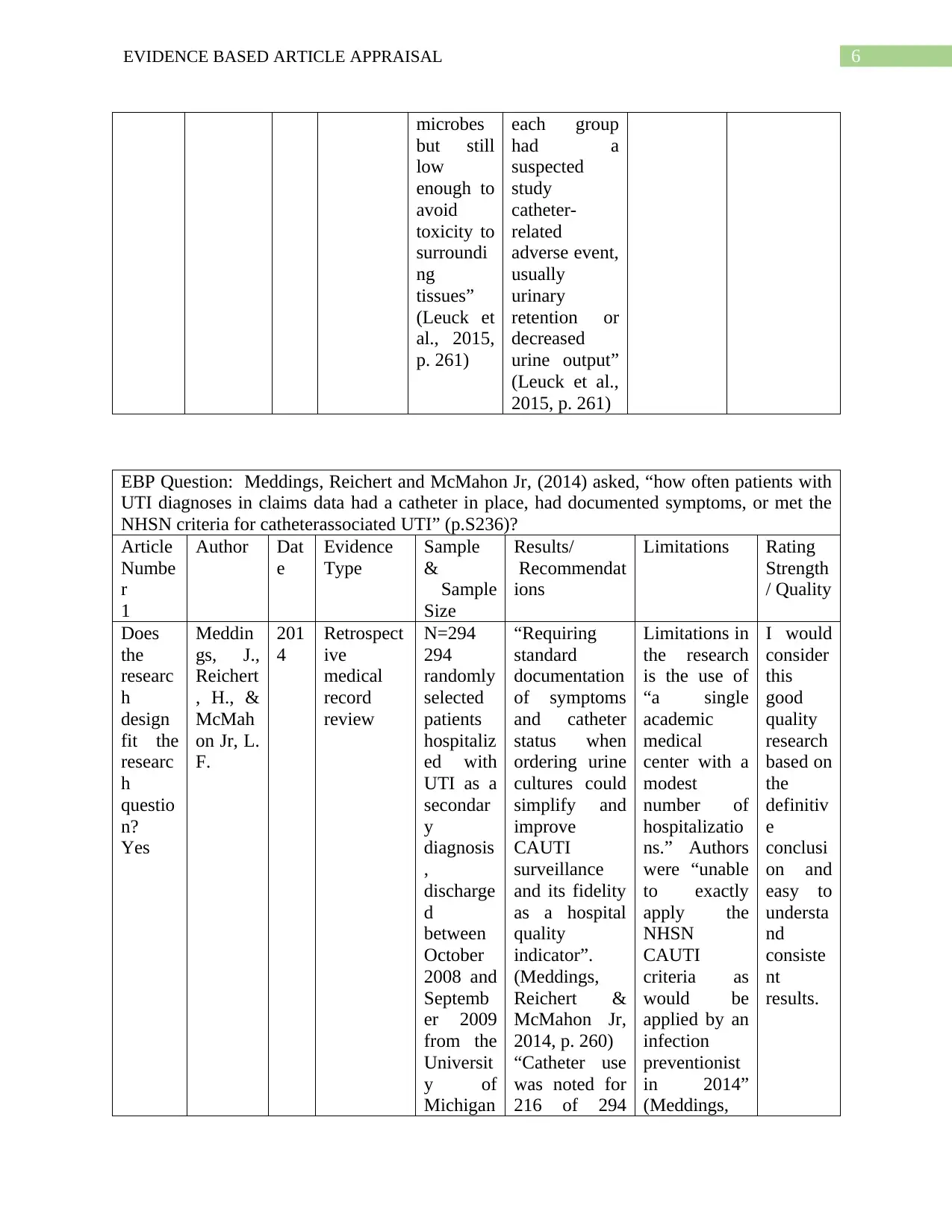
6EVIDENCE BASED ARTICLE APPRAISAL
microbes
but still
low
enough to
avoid
toxicity to
surroundi
ng
tissues”
(Leuck et
al., 2015,
p. 261)
each group
had a
suspected
study
catheter-
related
adverse event,
usually
urinary
retention or
decreased
urine output”
(Leuck et al.,
2015, p. 261)
EBP Question: Meddings, Reichert and McMahon Jr, (2014) asked, “how often patients with
UTI diagnoses in claims data had a catheter in place, had documented symptoms, or met the
NHSN criteria for catheterassociated UTI” (p.S236)?
Article
Numbe
r
1
Author Dat
e
Evidence
Type
Sample
&
Sample
Size
Results/
Recommendat
ions
Limitations Rating
Strength
/ Quality
Does
the
researc
h
design
fit the
researc
h
questio
n?
Yes
Meddin
gs, J.,
Reichert
, H., &
McMah
on Jr, L.
F.
201
4
Retrospect
ive
medical
record
review
N=294
294
randomly
selected
patients
hospitaliz
ed with
UTI as a
secondar
y
diagnosis
,
discharge
d
between
October
2008 and
Septemb
er 2009
from the
Universit
y of
Michigan
“Requiring
standard
documentation
of symptoms
and catheter
status when
ordering urine
cultures could
simplify and
improve
CAUTI
surveillance
and its fidelity
as a hospital
quality
indicator”.
(Meddings,
Reichert &
McMahon Jr,
2014, p. 260)
“Catheter use
was noted for
216 of 294
Limitations in
the research
is the use of
“a single
academic
medical
center with a
modest
number of
hospitalizatio
ns.” Authors
were “unable
to exactly
apply the
NHSN
CAUTI
criteria as
would be
applied by an
infection
preventionist
in 2014”
(Meddings,
I would
consider
this
good
quality
research
based on
the
definitiv
e
conclusi
on and
easy to
understa
nd
consiste
nt
results.
microbes
but still
low
enough to
avoid
toxicity to
surroundi
ng
tissues”
(Leuck et
al., 2015,
p. 261)
each group
had a
suspected
study
catheter-
related
adverse event,
usually
urinary
retention or
decreased
urine output”
(Leuck et al.,
2015, p. 261)
EBP Question: Meddings, Reichert and McMahon Jr, (2014) asked, “how often patients with
UTI diagnoses in claims data had a catheter in place, had documented symptoms, or met the
NHSN criteria for catheterassociated UTI” (p.S236)?
Article
Numbe
r
1
Author Dat
e
Evidence
Type
Sample
&
Sample
Size
Results/
Recommendat
ions
Limitations Rating
Strength
/ Quality
Does
the
researc
h
design
fit the
researc
h
questio
n?
Yes
Meddin
gs, J.,
Reichert
, H., &
McMah
on Jr, L.
F.
201
4
Retrospect
ive
medical
record
review
N=294
294
randomly
selected
patients
hospitaliz
ed with
UTI as a
secondar
y
diagnosis
,
discharge
d
between
October
2008 and
Septemb
er 2009
from the
Universit
y of
Michigan
“Requiring
standard
documentation
of symptoms
and catheter
status when
ordering urine
cultures could
simplify and
improve
CAUTI
surveillance
and its fidelity
as a hospital
quality
indicator”.
(Meddings,
Reichert &
McMahon Jr,
2014, p. 260)
“Catheter use
was noted for
216 of 294
Limitations in
the research
is the use of
“a single
academic
medical
center with a
modest
number of
hospitalizatio
ns.” Authors
were “unable
to exactly
apply the
NHSN
CAUTI
criteria as
would be
applied by an
infection
preventionist
in 2014”
(Meddings,
I would
consider
this
good
quality
research
based on
the
definitiv
e
conclusi
on and
easy to
understa
nd
consiste
nt
results.
Paraphrase This Document
Need a fresh take? Get an instant paraphrase of this document with our AI Paraphraser
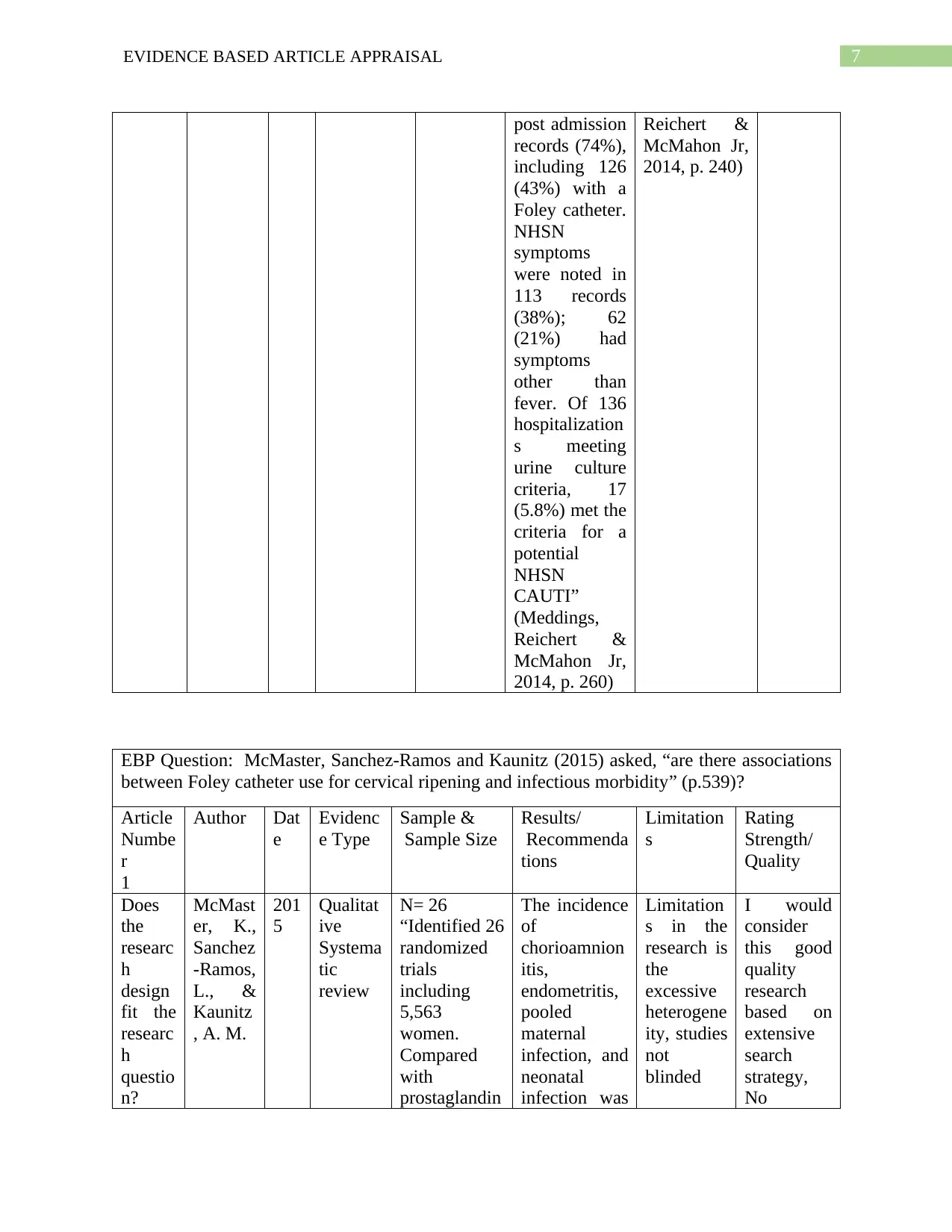
7EVIDENCE BASED ARTICLE APPRAISAL
post admission
records (74%),
including 126
(43%) with a
Foley catheter.
NHSN
symptoms
were noted in
113 records
(38%); 62
(21%) had
symptoms
other than
fever. Of 136
hospitalization
s meeting
urine culture
criteria, 17
(5.8%) met the
criteria for a
potential
NHSN
CAUTI”
(Meddings,
Reichert &
McMahon Jr,
2014, p. 260)
Reichert &
McMahon Jr,
2014, p. 240)
EBP Question: McMaster, Sanchez-Ramos and Kaunitz (2015) asked, “are there associations
between Foley catheter use for cervical ripening and infectious morbidity” (p.539)?
Article
Numbe
r
1
Author Dat
e
Evidenc
e Type
Sample &
Sample Size
Results/
Recommenda
tions
Limitation
s
Rating
Strength/
Quality
Does
the
researc
h
design
fit the
researc
h
questio
n?
McMast
er, K.,
Sanchez
-Ramos,
L., &
Kaunitz
, A. M.
201
5
Qualitat
ive
Systema
tic
review
N= 26
“Identified 26
randomized
trials
including
5,563
women.
Compared
with
prostaglandin
The incidence
of
chorioamnion
itis,
endometritis,
pooled
maternal
infection, and
neonatal
infection was
Limitation
s in the
research is
the
excessive
heterogene
ity, studies
not
blinded
I would
consider
this good
quality
research
based on
extensive
search
strategy,
No
post admission
records (74%),
including 126
(43%) with a
Foley catheter.
NHSN
symptoms
were noted in
113 records
(38%); 62
(21%) had
symptoms
other than
fever. Of 136
hospitalization
s meeting
urine culture
criteria, 17
(5.8%) met the
criteria for a
potential
NHSN
CAUTI”
(Meddings,
Reichert &
McMahon Jr,
2014, p. 260)
Reichert &
McMahon Jr,
2014, p. 240)
EBP Question: McMaster, Sanchez-Ramos and Kaunitz (2015) asked, “are there associations
between Foley catheter use for cervical ripening and infectious morbidity” (p.539)?
Article
Numbe
r
1
Author Dat
e
Evidenc
e Type
Sample &
Sample Size
Results/
Recommenda
tions
Limitation
s
Rating
Strength/
Quality
Does
the
researc
h
design
fit the
researc
h
questio
n?
McMast
er, K.,
Sanchez
-Ramos,
L., &
Kaunitz
, A. M.
201
5
Qualitat
ive
Systema
tic
review
N= 26
“Identified 26
randomized
trials
including
5,563
women.
Compared
with
prostaglandin
The incidence
of
chorioamnion
itis,
endometritis,
pooled
maternal
infection, and
neonatal
infection was
Limitation
s in the
research is
the
excessive
heterogene
ity, studies
not
blinded
I would
consider
this good
quality
research
based on
extensive
search
strategy,
No
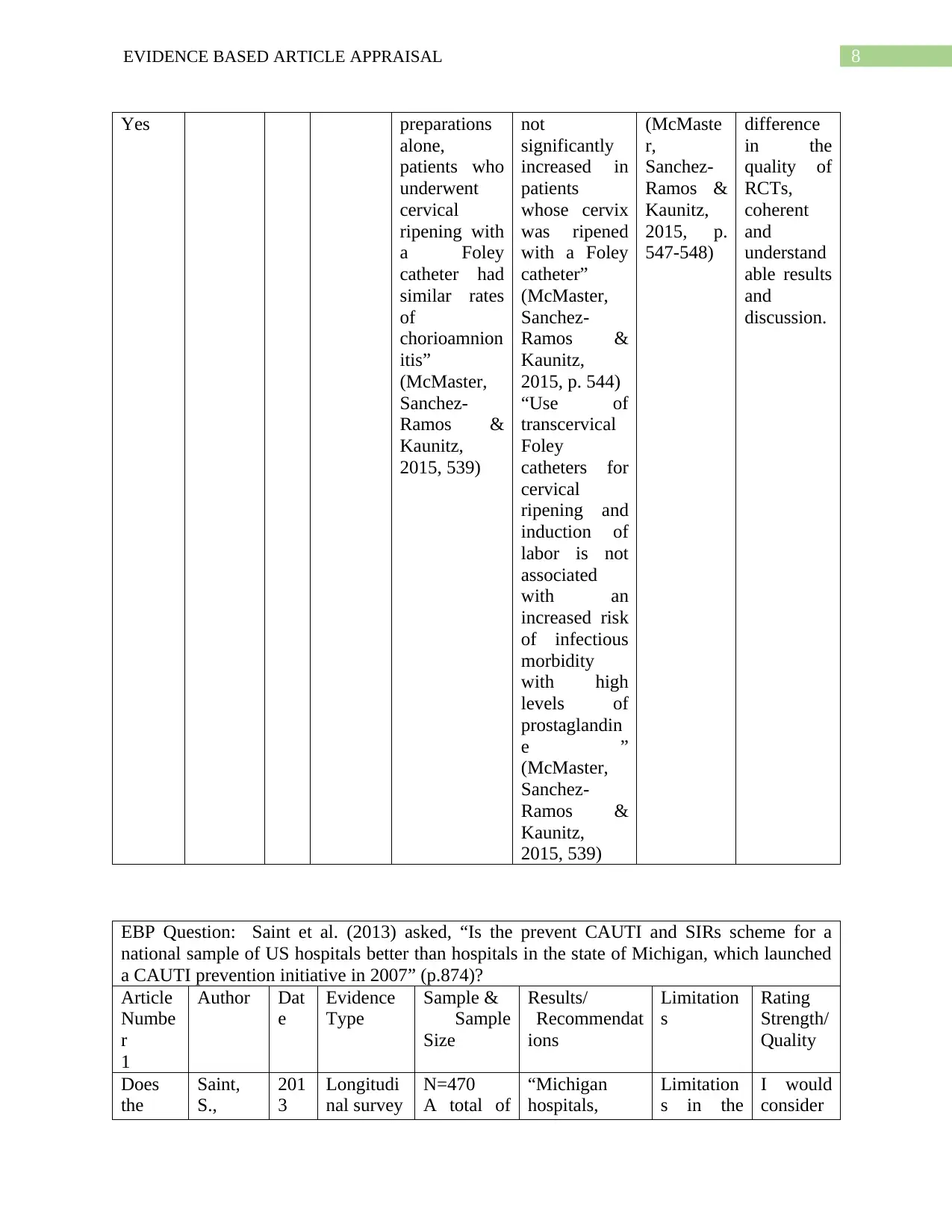
8EVIDENCE BASED ARTICLE APPRAISAL
Yes preparations
alone,
patients who
underwent
cervical
ripening with
a Foley
catheter had
similar rates
of
chorioamnion
itis”
(McMaster,
Sanchez-
Ramos &
Kaunitz,
2015, 539)
not
significantly
increased in
patients
whose cervix
was ripened
with a Foley
catheter”
(McMaster,
Sanchez-
Ramos &
Kaunitz,
2015, p. 544)
“Use of
transcervical
Foley
catheters for
cervical
ripening and
induction of
labor is not
associated
with an
increased risk
of infectious
morbidity
with high
levels of
prostaglandin
e ”
(McMaster,
Sanchez-
Ramos &
Kaunitz,
2015, 539)
(McMaste
r,
Sanchez-
Ramos &
Kaunitz,
2015, p.
547-548)
difference
in the
quality of
RCTs,
coherent
and
understand
able results
and
discussion.
EBP Question: Saint et al. (2013) asked, “Is the prevent CAUTI and SIRs scheme for a
national sample of US hospitals better than hospitals in the state of Michigan, which launched
a CAUTI prevention initiative in 2007” (p.874)?
Article
Numbe
r
1
Author Dat
e
Evidence
Type
Sample &
Sample
Size
Results/
Recommendat
ions
Limitation
s
Rating
Strength/
Quality
Does
the
Saint,
S.,
201
3
Longitudi
nal survey
N=470
A total of
“Michigan
hospitals,
Limitation
s in the
I would
consider
Yes preparations
alone,
patients who
underwent
cervical
ripening with
a Foley
catheter had
similar rates
of
chorioamnion
itis”
(McMaster,
Sanchez-
Ramos &
Kaunitz,
2015, 539)
not
significantly
increased in
patients
whose cervix
was ripened
with a Foley
catheter”
(McMaster,
Sanchez-
Ramos &
Kaunitz,
2015, p. 544)
“Use of
transcervical
Foley
catheters for
cervical
ripening and
induction of
labor is not
associated
with an
increased risk
of infectious
morbidity
with high
levels of
prostaglandin
e ”
(McMaster,
Sanchez-
Ramos &
Kaunitz,
2015, 539)
(McMaste
r,
Sanchez-
Ramos &
Kaunitz,
2015, p.
547-548)
difference
in the
quality of
RCTs,
coherent
and
understand
able results
and
discussion.
EBP Question: Saint et al. (2013) asked, “Is the prevent CAUTI and SIRs scheme for a
national sample of US hospitals better than hospitals in the state of Michigan, which launched
a CAUTI prevention initiative in 2007” (p.874)?
Article
Numbe
r
1
Author Dat
e
Evidence
Type
Sample &
Sample
Size
Results/
Recommendat
ions
Limitation
s
Rating
Strength/
Quality
Does
the
Saint,
S.,
201
3
Longitudi
nal survey
N=470
A total of
“Michigan
hospitals,
Limitation
s in the
I would
consider
⊘ This is a preview!⊘
Do you want full access?
Subscribe today to unlock all pages.

Trusted by 1+ million students worldwide
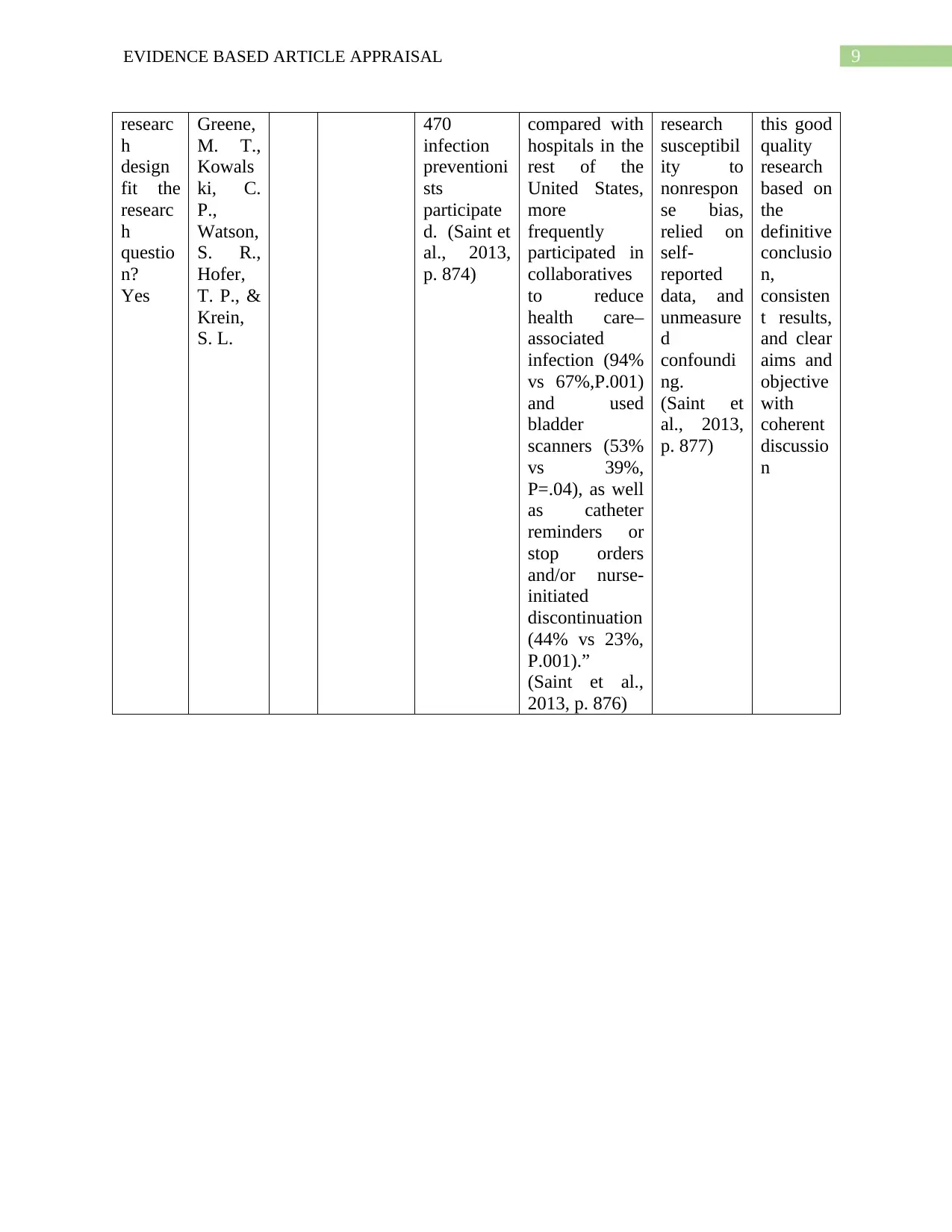
9EVIDENCE BASED ARTICLE APPRAISAL
researc
h
design
fit the
researc
h
questio
n?
Yes
Greene,
M. T.,
Kowals
ki, C.
P.,
Watson,
S. R.,
Hofer,
T. P., &
Krein,
S. L.
470
infection
preventioni
sts
participate
d. (Saint et
al., 2013,
p. 874)
compared with
hospitals in the
rest of the
United States,
more
frequently
participated in
collaboratives
to reduce
health care–
associated
infection (94%
vs 67%,P.001)
and used
bladder
scanners (53%
vs 39%,
P=.04), as well
as catheter
reminders or
stop orders
and/or nurse-
initiated
discontinuation
(44% vs 23%,
P.001).”
(Saint et al.,
2013, p. 876)
research
susceptibil
ity to
nonrespon
se bias,
relied on
self-
reported
data, and
unmeasure
d
confoundi
ng.
(Saint et
al., 2013,
p. 877)
this good
quality
research
based on
the
definitive
conclusio
n,
consisten
t results,
and clear
aims and
objective
with
coherent
discussio
n
researc
h
design
fit the
researc
h
questio
n?
Yes
Greene,
M. T.,
Kowals
ki, C.
P.,
Watson,
S. R.,
Hofer,
T. P., &
Krein,
S. L.
470
infection
preventioni
sts
participate
d. (Saint et
al., 2013,
p. 874)
compared with
hospitals in the
rest of the
United States,
more
frequently
participated in
collaboratives
to reduce
health care–
associated
infection (94%
vs 67%,P.001)
and used
bladder
scanners (53%
vs 39%,
P=.04), as well
as catheter
reminders or
stop orders
and/or nurse-
initiated
discontinuation
(44% vs 23%,
P.001).”
(Saint et al.,
2013, p. 876)
research
susceptibil
ity to
nonrespon
se bias,
relied on
self-
reported
data, and
unmeasure
d
confoundi
ng.
(Saint et
al., 2013,
p. 877)
this good
quality
research
based on
the
definitive
conclusio
n,
consisten
t results,
and clear
aims and
objective
with
coherent
discussio
n
Paraphrase This Document
Need a fresh take? Get an instant paraphrase of this document with our AI Paraphraser
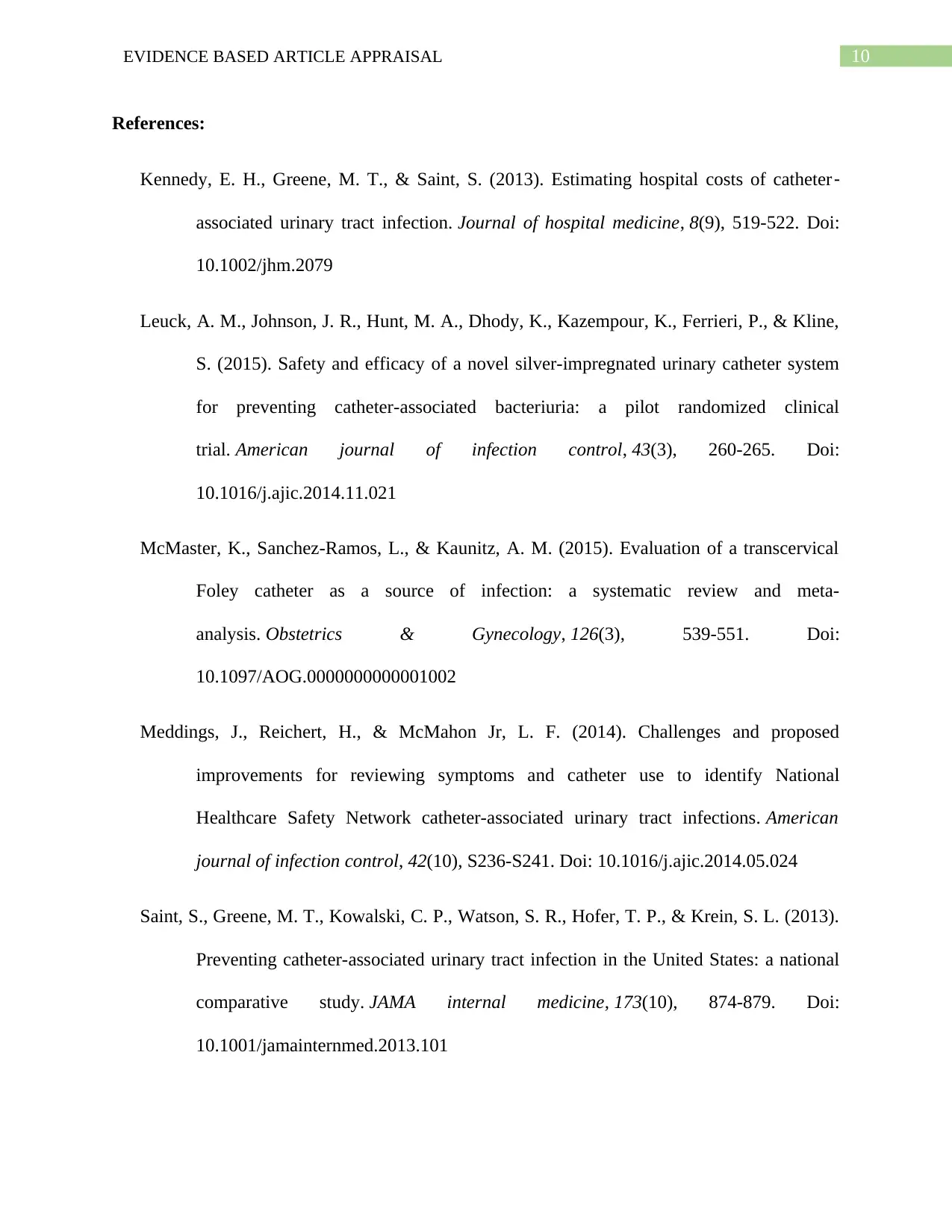
10EVIDENCE BASED ARTICLE APPRAISAL
References:
Kennedy, E. H., Greene, M. T., & Saint, S. (2013). Estimating hospital costs of catheter‐
associated urinary tract infection. Journal of hospital medicine, 8(9), 519-522. Doi:
10.1002/jhm.2079
Leuck, A. M., Johnson, J. R., Hunt, M. A., Dhody, K., Kazempour, K., Ferrieri, P., & Kline,
S. (2015). Safety and efficacy of a novel silver-impregnated urinary catheter system
for preventing catheter-associated bacteriuria: a pilot randomized clinical
trial. American journal of infection control, 43(3), 260-265. Doi:
10.1016/j.ajic.2014.11.021
McMaster, K., Sanchez-Ramos, L., & Kaunitz, A. M. (2015). Evaluation of a transcervical
Foley catheter as a source of infection: a systematic review and meta-
analysis. Obstetrics & Gynecology, 126(3), 539-551. Doi:
10.1097/AOG.0000000000001002
Meddings, J., Reichert, H., & McMahon Jr, L. F. (2014). Challenges and proposed
improvements for reviewing symptoms and catheter use to identify National
Healthcare Safety Network catheter-associated urinary tract infections. American
journal of infection control, 42(10), S236-S241. Doi: 10.1016/j.ajic.2014.05.024
Saint, S., Greene, M. T., Kowalski, C. P., Watson, S. R., Hofer, T. P., & Krein, S. L. (2013).
Preventing catheter-associated urinary tract infection in the United States: a national
comparative study. JAMA internal medicine, 173(10), 874-879. Doi:
10.1001/jamainternmed.2013.101
References:
Kennedy, E. H., Greene, M. T., & Saint, S. (2013). Estimating hospital costs of catheter‐
associated urinary tract infection. Journal of hospital medicine, 8(9), 519-522. Doi:
10.1002/jhm.2079
Leuck, A. M., Johnson, J. R., Hunt, M. A., Dhody, K., Kazempour, K., Ferrieri, P., & Kline,
S. (2015). Safety and efficacy of a novel silver-impregnated urinary catheter system
for preventing catheter-associated bacteriuria: a pilot randomized clinical
trial. American journal of infection control, 43(3), 260-265. Doi:
10.1016/j.ajic.2014.11.021
McMaster, K., Sanchez-Ramos, L., & Kaunitz, A. M. (2015). Evaluation of a transcervical
Foley catheter as a source of infection: a systematic review and meta-
analysis. Obstetrics & Gynecology, 126(3), 539-551. Doi:
10.1097/AOG.0000000000001002
Meddings, J., Reichert, H., & McMahon Jr, L. F. (2014). Challenges and proposed
improvements for reviewing symptoms and catheter use to identify National
Healthcare Safety Network catheter-associated urinary tract infections. American
journal of infection control, 42(10), S236-S241. Doi: 10.1016/j.ajic.2014.05.024
Saint, S., Greene, M. T., Kowalski, C. P., Watson, S. R., Hofer, T. P., & Krein, S. L. (2013).
Preventing catheter-associated urinary tract infection in the United States: a national
comparative study. JAMA internal medicine, 173(10), 874-879. Doi:
10.1001/jamainternmed.2013.101

11EVIDENCE BASED ARTICLE APPRAISAL
Shaver, B., Eyerly-Webb, S. A., Gibney, Z., Silverman, L., Pineda, C., & Solomon, R. J.
(2018). Trauma and Intensive Care Nursing Knowledge and Attitude of Foley
Catheter Insertion and Maintenance. Journal of trauma nursing: the official journal
of the Society of Trauma Nurses, 25(1), 66. Doi: 10.1097/JTN.0000000000000344
Shaver, B., Eyerly-Webb, S. A., Gibney, Z., Silverman, L., Pineda, C., & Solomon, R. J.
(2018). Trauma and Intensive Care Nursing Knowledge and Attitude of Foley
Catheter Insertion and Maintenance. Journal of trauma nursing: the official journal
of the Society of Trauma Nurses, 25(1), 66. Doi: 10.1097/JTN.0000000000000344
⊘ This is a preview!⊘
Do you want full access?
Subscribe today to unlock all pages.

Trusted by 1+ million students worldwide
1 out of 12
Your All-in-One AI-Powered Toolkit for Academic Success.
+13062052269
info@desklib.com
Available 24*7 on WhatsApp / Email
![[object Object]](/_next/static/media/star-bottom.7253800d.svg)
Unlock your academic potential
Copyright © 2020–2025 A2Z Services. All Rights Reserved. Developed and managed by ZUCOL.